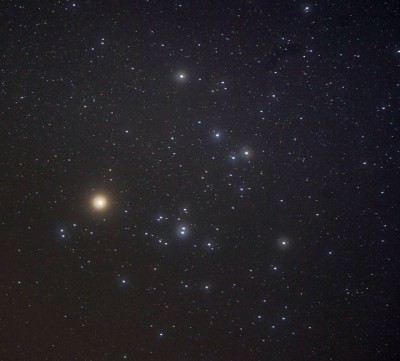Yes, I remember this picture. I didn't like it. You can guess why. The colors seemed strange and, to me, unpleasant. (
I know.)
Okay. Let me be a little more productive. How old is this cluster?
NGC 290. NASA, ESA, Hubble; Acknowledgement: E. Olzewski
The Hyades. Photo: Bob King.
Let's compare NGC 290 with the Hyades. How old is the Hyades? According to
Ruth Angus of Astrobites, the Hyades is generally thought to be 625 million years old, but may be as old as 750 or even 950 million years old, if you factor in stellar rotation. Whatever.
As you can see, however, NGC 290 is a totally different sort of cluster than the Hyades. The stars are close together in NGC 290, or at least centrally concentrated, while they are quite far apart in the Hyades. The brightest stars are more or less equally bright in the Hyades, while they come in many different magnitudes in NGC 290. The brightest stars in the Hyades are fairly colorless - the bluest stars are not very blue, and the reddest stars not very red (of course you know that red giant Aldebaran is a foreground star and not a member of the cluster), while in NGC 290 they appear to come in many different colors.
But the colors of the stars in NGC 290 are confusing. There is one bright orange star in NGC 290, but it is located some distance away from the cluster center. Is it even a member of the cluster? There are orange stars well inside the cluster center, but they are clearly fainter than some of the bluer stars. At the same time they are at least moderately bright. This is not what we expect from stellar evolution.
Also the bluest stars seem to be located in the periphery of the cluster. However, there are also orange stars located here. How weird. The brightest stars in the middle are a disgusting turquoise color. (Sorry. Couldn't resist.)
Okay, I'll have a guess as to the age of this cluster. It is clearly younger than the Hyades, if only because the there is such a central concentration of stars in it, and because the stars are of such different brightnesses.
But NGC 290 is also different from the Hyades because it is obviously so very much richer and more massive than the Hyades. So maybe we should compare it with rich open cluster instead of the Hyades, then.
Rich open cluster M11. ESA/Hubble.
Rich open cluster M11. Fort Lewis College - Department of Physics & Engineering.
According to
Wikipedia, the estimated age of M11 is 316±50 million years. As you can see from the picture at right, the bright stars of M11 seem to be of about equal brightness. The cluster, while rich, is not centrally concentrated. (On the other hand, the extremely rich globular cluster Omega Centauri is not centrally concentrated, either.) Although the overall impression of M11 is that it is a bluish cluster, the Hubble closeup of a part of the cluster shows a mixture of blue and orange stars.
The apparent difference in brightness in stars in NGC 290 makes it look younger than M11. M11 is so old that all its truly bright stars have already died. NGC 290 still appears to have some truly bright stars, but probably no true supergiants.
I'll have a guess and say that NGC 290 is about 50-75 million years old.
Ann
 A Stellar Jewel Box: Open Cluster NGC 290
A Stellar Jewel Box: Open Cluster NGC 290




